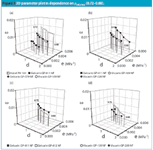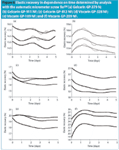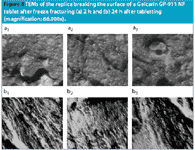Carrageenans: Analysis of Tablet Formation and Properties (Part II)
Pharmaceutical Technology Europe
The tablet formation of six different carrageenans was analysed by 3D modelling, Heckel analysis, the pressure–time function and energy calculations. It was found that the fibres experienced plastic deformation, which was accompanied by a great deal of elasticity. Measurement of elastic recovery in dependence on maximum relative density and time showed that relaxation is completed a considerable amount of time after tabletting. Shrinking of the fibres occurred in parallel with elastic recovery as a result of the reorganization of the fibre structure. The tabletting behaviour of carrageenans makes them suitable for the soft tabletting of pressure sensitive materials.
The first part of this article discussed the latest information regarding carrageenans and tabletting. This article will describe the results and discussion on tabletting, the final formation of the tablets and tablet properties. Finally, general conclusions on the tabletting of carrageenans will be drawn.
Results and Discussion (continued)Tabletting
The tabletting behaviour was characterized by 3D modelling (Figure 1). Heckel analysis (Figure 2[a]), determination of the parameters of the pressure–time function (Figure 2[b]), and energy calculations from the force–displacement profile (Figures 2[c] and [d]) were used in comparison. Figure 1(a) shows different types of carrageenan (κ, ι, and λ) compared with microcrystalline cellulose (MCC). For all three types, pressure plasticity (e) is lower and fast elastic decompression (indicated by ω) is higher compared with MCC. The κ-carrageenan (Gel 911) and the λ-carrageenan (Vis 109) behaved similarly. The ι-carrageenan (Gel 379) showed lower e- and ω-values compared with both Gel 911 and Vis 109. In addition, for all the carrageenans (particularly Gel 379), time plasticity (d) was lower compared with MCC. In conclusion, the carrageenans are less plastic than MCC and exhibit much more elasticity already during tabletting. Brittle fracture can be excluded because the materials do not show the typical decrease in ω-values.22 The order of elasticity is ι>κ>λ.

Figure 1 3D parameter plot in dependence on Ïrel,max (0.72â0.88).
Because of its anhydrogalactose groups, which are also substituted with sulfate, Gel 379 is the most elastic material. Figure 2(a) shows the slope of the Heckel function for the different types of carrageenan. For five of the six carrageenans the slope of the Heckel function is lower compared with MCC, indicating less deformation. However, the slope of the Heckel function includes plastic and elastic deformation. As known from 3D modelling, the deformation of the carrageenans is mainly elastic deformation. Thus the order of elasticity is the same as by 3D modelling. Figure 2(b) shows the results of the pressure-time
function in the β–γ diagram. All carrageenans are much more elastic than MCC. Distinguishing the different carrageenans is not as easily possible using this method. However, Gel 379 exhibits the highest β-values and is thus the most elastic material. Finally, Figures 2(c) and (d) illustrate that Gel 379 is the most elastic material. However, the differences between the carrageenans are slight using this method.

Figure 2 (a) Heckel slope, (b) βâγ diagram, (c) plastic and (d) elastic energy in dependence on Ïrel,max determined for six different carrageenans and MCC (mean6SD).
Figure 1(b) shows the tabletting behaviour of Vis 328, a material that consists of both κ- and λ-carrageenan. It was assumed that its behaviour does not differ from Gel 911 and Vis 109. However, the result shows that this composite material is much more plastic in its behaviour; d and e are higher compared with the pure types. Furthermore, fast elastic decompression is lower because ω is higher. The Heckel analysis (Figure 2[a]) underlines this result as the slope of the Heckel function is the highest of all materials. The β–γ diagram (Figure 2[b]) and energy calculations (Figures 2[c] and [d]) show fewer differences. Vis 328 behaves similarly to Vis 109. A reason for this high plasticity might be that in this composite product the texture of the fibres is less homogeneous and thus, the fibres deform more plastic.
Figure 1(c) shows the deformation behaviour of Gel 812, a κ-carrageenan, which contains more potassium ions than Gel 911.24 d and e are similar to Gel 911. However, this material exhibits a little more elasticity, which is indicated in the lower ω-values. This difference was significant (α=0.05) for all maximum relative densities, ρrel,max. The Heckel analysis (Figure 2[a]) and energy calculations (Figure 2[c]) show that Gel 812 is less plastic compared with Gel 911; the slope of the Heckel function and plastic energy is lower. Obviously the potassium ions in Gel 812 induce more relaxation during tabletting compared with Gel 911. Again, the β–γ diagram (Figure 2[b]) shows fewer differences compared with the other methods. Gel 812 behaves similar to Gel 911, except for the lowest maximum relative density (0.72).
Finally, Figure 1(d) shows Vis 209, the particles of which are bigger than those of Vis 109. This was proven by laser diffractometry (Figure 4, Part I). For Vis 209, d and e are slightly lower compared with Vis 109. Moreover, this material exhibits lower ω-values and shows thus higher fast elastic decompression. Obviously the bigger particles deform less plastically and exhibit more elasticity. The decrease of e at low densification indicates crushing of the particles as for brittle materials.22 This result is underlined by a lower Heckel slope for Vis 209, higher β-values (in the β–γ diagram) and slightly higher elastic energy (Figure 2[d]). The powder shows more resistance to pressure.
Because the carrageenans contain much more water than MCC and show sorption with increasing humidity, tabletting was analysed exemplarily for Gel 911 at different relative humidities (RHs). Figure 3(a) shows the results for tabletting at different RHs by 3D modelling. With increasing humidity and increasing water content, d and e increase, and fast elastic decompression decreases. This result is similar as for MCC (Figure 3[b]), although much more pronounced compared with MCC.

Figure 3 3D parameter plot in dependence on Ïrel,max (0.72â0.88) of (a) Gelcarin GP-911 and (b) Avicel PH 102 at four different RHs.
Final Formation of the Tablets
Figure 4 shows the elastic recovery of tablets made of carrageenan compared with MCC. For all carrageenan tablets, elastic recovery is higher compared with those made of MCC. Relaxation, which already started during tabletting, continues. Elastic recovery is different for the different types of carrageenan. Tablets made of κ-carrageenans (Gel 911 and Gel 812) showed higher elastic recovery than those made of the ι-type (Gel 379). The order was inverse for fast elastic decompression. Tablets made of the λ-carrageenan (Vis 109) and of Vis 328 exhibit less elastic recovery. This behaviour conforms with the behaviour during tabletting. The λ-carrageenan tablets (Vis 209) demonstrated higher elastic recovery after tabletting. For this type, particle size is the reason, as its bigger carrageenan particles relax more.

Figure 4 Elastic recovery in dependence on rrel,max of six different carrageenans and MCC (mean6SD); (a) directly after tabletting and (b) 10 days after tabletting.
In summary, for a great deal the process of tablet formation continues after tabletting. Thus, to fully illustrate tablet formation, elastic recovery after tabletting was determined in dependence on time.
Figure 5 shows the results for elastic recovery obtained by thermomechanical analysis at constant temperature. To rule out the influence of the applied slight force during thermomechanical analysis, experiments were also performed with the automatic micrometer screw.34 This is a contactless measurement. Figure 6 shows similar results as they were obtained with thermomechanical analysis.

Figure 5 Elastic recovery in dependence on time determined by thermomechanical analysis at constant temperature for (a) Gelcarin GP-379 NF; (b) Gelcarin GP-911 NF; (c) Gelcarin GP-812 NF; (d) Viscarin GP-328 NF; (e) Viscarin GP-109 NF; and (f) Viscarin GP-209 NF.
For tablets of all three types of carrageenan, in the beginning an increase in elastic recovery followed by a decrease in elastic recovery was observed. Most probably parallel to the relaxation of the tablets after tabletting a shrinking of the tablets occurred.35 This process is most pronounced for tablets made with
κ- and ι-carrageenan (Figure 6 [a–d]). Tablets made of λ-carrageenan exhibit less shrinking (Figure 6 [e and f]). Thus, a shrinking (S) order can be established: S(κ-carrageenan)>S(ι-carrageenan) >S(λ-carrageenan). During all experiments tablet mass remained constant and thus, the tablets did not dry.

Figure 6 Elastic recovery in dependence on time determined by analysis with the automatic micrometer screw for34 (a) Gelcarin GP-379 N; (b) Gelcarin GP-911 NF; (c) Gelcarin GP-812 NF; (d) Viscarin GP-328 NF; (e) Viscarin GP-109 NF; and (f) Viscarin GP-209 NF.
How can this shrinking be proven? What is the reason? Density measurements with carrageenan tablets after tabletting showed that the apparent density of the tablets, as determined by helium pycnometry, increased with storage time (0.052 g/cm3 (repetitions n=10). This density increase could be caused by a reorganization in the fibre structure caused by the force applied during tabletting.35 Environmental scanning electron micrographs (ESEMs) of a Gel 911 tablet (Figure 7) produced by video analysis show that indeed fibre shrinking occurred after tabletting. Figure 7 shows precisely the same breaking surface of a tablet (a) 30 min and (b) 12 h after tabletting. The tablet remained at constant humidity in the ESEM. The fibre strength decreased and also the gaps between the fibres increased.

Figure 7 SEMs (first line) and black and white images of the SEMs (second line) of the same location at the breaking surface of a Gelcarin GP-911 NF tablet at 40% RH (ESEM); (a) 30 min and (b) 12 h after tabletting.
The result proves that following tabletting, changes in the material took place that caused the increase in density. To analyse the fibre structure more precisely, the breaking surface of Gel 911 tablets were analysed by transmission electron microscopy (TEM) after freeze fracturing (Figure 8). After 24 h (Figure 8[b]) stripes were visible that could not be detected 2 h (Figure 8[a]) after tabletting. A mechanical activation occurred that caused changes in the fibre structure and lead to the tablets shrinking. This mechanical activation can contribute to bonding.

Figure 8 TEMs of the replica breaking the surface of a Gelcarin GP-911 NF tablet after freeze fracturing (a) 2 h and (b) 24 h after tabletting (magnification: 66.000x).
Tablet Properties
As shown in Figure 5, Part I the tablets were analysed on the upper and breaking surfaces after tabletting and relaxation. Compared with MCC (Figure 5[b(g)], Part I) both surfaces show a high porosity and a loose entanglement of the fibres, even the upper surface of the tablets is not plane. Mechanical interlocking is of importance for bonding. The fibres are less deformed than the MCC fibres, and this could enable their suitability for soft tabletting. A reason for this behaviour might be the low glass transition temperature (Tg) of the carrageenans (Table 1, Part I). The carrageenans are at room temperature in the rubbery state, MCC is in the glassy state. Tablets made with λ-carrageenan (Vis 109, Vis 209 and Vis 328 [Figure 5(b), Part I] seem to be more loose in structure than tablets made of the ι- and κ-carrageenans (Gel 379, Gel 911 and Gel 812 [Figure 5(a), Part I].
Despite the loose structure of the carrageenan tablets, mechanically stable tablets were obtained for all types of carrageenan (Figure 9). However, the slope in the compactibility plot is much lower compared with MCC; obviously the high elasticity of the carrageenans reduces crushing force. In all cases, the crushing force is satisfying and thus, bonding inside the tablet is sufficient for mechanical stability.

Figure 9 Compactibility plot of six different carrageenans and MCC (mean6SD).
Conclusions
Carrageenans form tablets by plastic deformation. Simultaneously, the materials exhibit elastic relaxation of the tablets, particularly for ι- and κ-carrageenans. After tabletting, relaxation continues to different extents for the various types of carrageenan. Overall, elastic recovery is higher compared with most of the usually used tabletting materials. However, mechanically stable tablets are formed. The compaction energy is used for plastic deformation and a reorganization of the fibre structure. Part of the energy is released in the form of elastic recovery. Thus, less energy is transformed into pure plastic deformation.
In summary, the special tabletting behaviour of the carrageenans described here enables them to be useful for soft tabletting of pressure-sensitive materials.12–14
Acknowledgments
The author gratefully acknowledges Prof. Dr. C.C. Müller Goymann, Institute of Pharmaceutical Technology, Technical University of Brunswick (Germany) for the use of freeze fracturing and TEM, Dr.-Ing. K. Legenhausen, Institute of Mechanical Engineering, Technical University Clausthal-Zellerfeld (Germany) for the use of laser light diffractometry, and Lehmann & Voss, Hamburg (Germany) for donation of materials.
Katharina M. Picker-Freyer is associate professor (Private Docent) at the Institute of Pharmaceutical Technology and Biopharmacy Martin-Luther-University Halle-Wittenberg, Germany.
References
1. M. Nakano and A. Ogata, Chem. Pharm. Bull.32, 782–785 (1984).
2. M. Delalonde et al., J. Pharm. Belg. 49, 301–307 (1994).
3. M.C. Bonferoni et al., J. Contr. Rel. 26, 119–127 (1993).
4. M.C. Bonferoni et al., J. Contr. Rel. 30, 175–182 (1994).
5. M. Hariharan, T.A. Wheatley and J.C. Price, Pharm. Dev. Technol. 2, 383–393 (1997).
6. H.Y. Park et al., Drug Delivery 5(1), 13–18 (1998).
7. K.M. Picker, Drug Dev. Ind. Pharm. 25(3), 339–346 (1999).
8. K.M. Picker, Eur. J. Pharm. Biopharm. 48(1), 27–36 (1999).
9. M.C. Bonferoni et al., J. Contr. Rel. 51, 231-239 (1998).
10. V.K. Gupta et al., Eur. J. Pharm. Biopharm. 51(3), 241–248 (2001).
11. M.C. Bonferoni et al., Pharm. Dev. Technol. 9(2), 155–162 (2004).
12. K.M. Picker, Eur. J. Pharm. Biopharm. 53, 181–185 (2002).
13. A.G. Schmidt, S. Wartewig and K.M. Picker, Eur. J. Pharm. Biopharm. 56, 101–110 (2003).
14. K.M. Picker, Pharm. Dev. Technol. 9(1) 107–121 (2004).
15. A.C.J. Voragen, W. Pillnik and I. Challen, "Polysaccharides — Carrageenans," in Ullmann's Encyclopedia of Industrial Chemistry (Electronic release, 2000).
16. USP 27/NF 22, The United States Pharmacopoeia/The National Formulary (United States Pharmacopeia, 12601 Twinbrook Parkway, Rockville, MD 20852-1790, USA, 2003).
17. D.B. Smith and W.H. Cook, Arch. Biochem. Biophys. 45, 232–233 (1953).
18. A.N. O'Neill, J.Am. Chem. Soc. 77, 1821–1832 (1955).
19. M. Mitsuiki et al., J. Agric. Food Chem. 46, 3528–3534 (1998).
20. K.M. Picker, Eur. J. Pharm. Biopharm. 49(3), 267–273 (2000).
21. K.M. Picker and F. Bikane, Pharm. Dev. Technol. 6(3), 333–342 (2001).
22. K.M. Picker, Drug Dev. Ind. Pharm. 30(4), 413–425 (2004).
23. K.M. Picker, AAPS PharmSciTech. 4(3), article 35 (2003).
24. FMC Corp., Personal communication, 1997.
25. L. Greenspan, J. Res.Nat. Bur. Stand. 81A, 89–96 (1977).
26. K.M. Picker and J.B. Mielck, Eur. J. Pharm.Biopharm. 42, 82–84 (1996).
27. Pharmacopea Europea 2002 (Deutscher Apotheker Verlag, Stuttgart, Govi Pharm. Verlag, Eschborn, Germany).
28. R.L. Carr, Chem. Eng. 72, 163–168 (1965).
29. K.M. Picker and S.W. Hoag, J. Pharm. Sci. 9(2), 342–349 (2002).
30. R.W. Heckel, Trans. Metall. Soc. AIME 221, 1001–1008 (1961).
31. R. Dietrich and J.B. Mielck, Pharm. Ind. 47, 216–220 (1985).
32. C. Führer Dtsch. Apoth. Ztg. 102, 827–842 (1962).
33. N.A. Armstrong and R.F. Haines-Nutt, J. Pharm. Pharmacol. 24S, 135P–136P (1972).
34. K.M. Picker, Eur. J. Pharm. Biopharm. 49(2), 171–176 (2000).
35. K.M. Picker, Pharm. Dev. Technol. 6(1), 61–70 (2001).

Drug Solutions Podcast: Applying Appropriate Analytics to Drug Development
March 26th 2024In this episode of the Drug Solutions Podcast, Jan Bekker, Vice President of Business Development, Commercial and Technical Operations at BioCina, discusses the latest analytical tools and their applications in the drug development market.